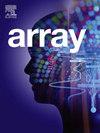NLP based text classification using TF-IDF enabled fine-tuned long short-term memory: An empirical analysis
IF 4.5
Q2 COMPUTER SCIENCE, THEORY & METHODS
引用次数: 0
Abstract
The rapid proliferation of information through digital transformation and the widespread use of social networking platforms has significantly increased the speed of information dissemination across urban and rural areas alike. While these platforms have become vital channels for sharing news, advertisements, and crucial updates, they also pose challenges in verifying the authenticity of the information in real-time. Addressing this issue, this study proposes a novel Convolutional Neural Networks (CNN)-Long Short-Term Memory (LSTM) model designed for the classification of fake news articles. A comprehensive dataset covering diverse categories, including government news, Middle East news, US news, left-wing news, and political content, was utilized in this research. Following preprocessing, features were extracted using the Term Frequency-Inverse Document Frequency (TF-IDF) technique, and word embeddings were generated for enhanced semantic representation. The combined CNN-LSTM model leverages the strengths of both architectures, capturing local patterns and long-range dependencies within the data. The experimental results demonstrate that the Fine-Tuned CNN-LSTM model outperforms all precedent approaches across various categories. Notably, the Fine-Tuned CNN-LSTM model achieves the highest accuracy (AC), ranging from 0.57 to 0.68, highlighting its superior classification performance to other precedent approaches, indicating their inefficacy in handling multiple categories.
基于NLP的文本分类使用TF-IDF启用微调长短期记忆:实证分析
数字化转型带来的信息快速扩散和社交网络平台的广泛使用,显著提高了城乡信息传播速度。虽然这些平台已经成为分享新闻、广告和重要更新的重要渠道,但它们也对实时验证信息的真实性提出了挑战。针对这一问题,本研究提出了一种新颖的卷积神经网络(CNN)长短期记忆(LSTM)模型,用于假新闻文章的分类。本研究使用了一个涵盖不同类别的综合数据集,包括政府新闻、中东新闻、美国新闻、左翼新闻和政治内容。预处理后,使用术语频率-逆文档频率(TF-IDF)技术提取特征,并生成词嵌入以增强语义表示。组合的CNN-LSTM模型利用了这两种体系结构的优势,捕获了数据中的本地模式和远程依赖关系。实验结果表明,经过微调的CNN-LSTM模型在各种类别上的性能都优于以往的所有方法。值得注意的是,微调CNN-LSTM模型达到了最高的准确率(AC),范围在0.57到0.68之间,突出了其优于其他先前方法的分类性能,表明它们在处理多类别时效果不佳。
本文章由计算机程序翻译,如有差异,请以英文原文为准。
求助全文
约1分钟内获得全文
求助全文

 求助内容:
求助内容: 应助结果提醒方式:
应助结果提醒方式:


